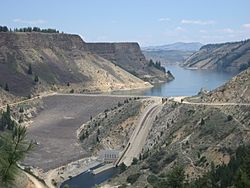Anderson Ranch Dam facts for kids
Quick facts for kids Anderson Ranch Dam |
|
|---|---|

Anderson Ranch Dam in August 2009
|
|
| Location | Elmore County, Idaho, U.S. |
| Coordinates | 43°21′27″N 115°26′55″W / 43.35750°N 115.44861°W |
| Construction began | 1941 |
| Opening date | 1950 |
| Operator(s) | U.S. Bureau of Reclamation |
| Dam and spillways | |
| Impounds | South Fork Boise River |
| Height | 456 feet (139 m) |
| Length | 1,350 feet (411 m) |
| Reservoir | |
| Creates | Anderson Ranch Reservoir |
| Total capacity | 503,500 acre-feet (0.621 km3) |
| Catchment area | 960 square miles (2,490 km2) |
| Surface area | 4,815 acres (19.5 km2) |
| Normal elevation | 4,190 ft (1,280 m) AMSL |
| Power station | |
| Commission date | 1951 (1986) |
| Turbines | 2 x 20 MW |
| Installed capacity | 40 MW |
The Anderson Ranch Dam is a huge structure built on the South Fork of the Boise River in Idaho, United States. It's located in Elmore County, northeast of Mountain Home. This dam is an earth rockfill type, meaning it's made mostly of compacted earth and rock.
The dam creates a large body of water called Anderson Ranch Reservoir. The top level of the water, where it would spill over, is about 4,196 feet (1,279 m) above sea level. When it was finished in 1950, Anderson Ranch Dam was the tallest dam of its kind anywhere in the world!
What the Dam Does
Anderson Ranch Dam serves two main purposes. Its most important job is to provide irrigation water. This water helps farmers grow crops in the dry lands of Idaho. The dam also generates hydroelectric power. This means it uses the force of moving water to create electricity. In 1986, the dam's ability to make electricity was increased from 27 megawatts (MW) to 40 MW.
Building the Dam
Building the Anderson Ranch Dam was a big project that started in 1941. It faced many challenges, especially because World War II was happening. There were shortages of materials, fuel, and even workers. Because of these problems, construction had to stop for more than nine months starting in late 1942.
Workers and Challenges
During the war, there were rules about who could work on certain projects. However, in 1943, the law was changed. This allowed Japanese American internees to help build important projects like Anderson Ranch Dam. These workers came from the Minidoka War Relocation Center. Their hard work helped complete this important dam.
The River and Its Home
The South Fork of the Boise River begins high up in the Smoky Mountains. The area where all the water flows into the river, called its watershed, includes parts of the Smoky Mountains, Soldier Mountains, Boise National Forest, and Sawtooth National Forest. After flowing through Anderson Ranch Dam, the South Fork continues its journey. It eventually flows into another reservoir behind the Arrowrock Dam, which was completed much earlier in 1915.

